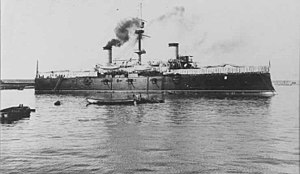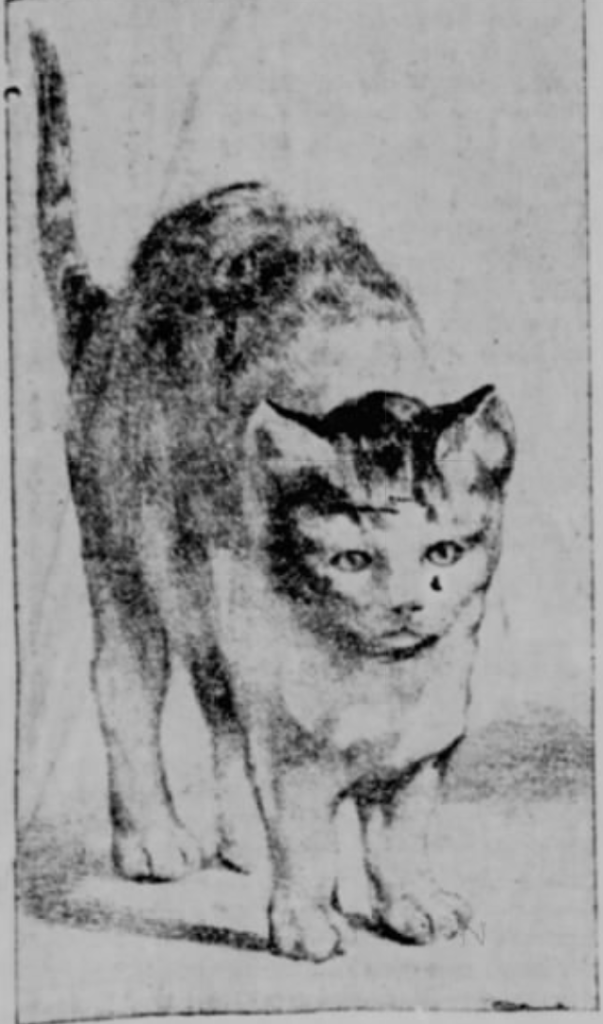
I once wrote about Tom, the famous cat that survived the explosion and sinking of the USS Maine during the Spanish-American War. The following tale is about several other seafaring cats who similarly survived naval events during the same war: these were the ship cats of the Cristóbal Colón, a Spanish cruiser that ran aground during the Battle of Santiago de Cuba.
The Battle of Santiago de Cuba
The Cristóbal Colón was one of four ships in the Spanish squadron led by Admiral Pascual Cervera y Topete during the Spanish-American War. During this time, Tonias Cervera (aka Thomas) and at least two other cats were members of the Cristóbal Colón crew.
The Battle of Santiago de Cuba was a short battle that came to a head on July 1, 1898. That day, Admiral Cervera decided that his squadron’s only hope was to try to escape into the open sea by running through the blockade of American battleships.

The Spanish cruiser Infanta Maria Teresa lead the escape, thus sacrificing herself by attacking the USS Brooklyn, the fastest American ship. Next in line were the ships Viscaya and Cristóbal Colón, which was the fastest of the Spanish fleet.
One by one, the Spanish ships began to lose power and beach on the shores. The Cristóbal Colón carried on, but on July 3, after taking six hits from the USS Brooklyn and USS Oregon, Captain Emilio Díaz-Moreu y Quintana had a decision to make.
The captain decided that in order to save the lives of his human and feline crew, he’d need to beach his ship near the mouth of the Tarquino River.

The Cristóbal Colón Ship Cats
Some of the ship’s sailors made it ashore that day, while others were rescued by American sailors who came alongside the wreck in small boats to take off survivors. At least two cats were also rescued on July 3.
According to news reports, “Fighting Bob” Evans of the battleship Oregon took one of the cats, and another feline was shipped to Captain Charles E. Clark of Michigan. A note attached to this cat read:
To a Good American: Treat me kindly and give me food, as I am a prisoner of war from the Cristobal Colon, being forwarded by my captors, the crew of the Oregon, to the gallant commander, Capt. Charles E. Clark, whose brave efforts forced the Colon to surrender July 3, 1898.
For some reason, Captain Clark could not keep the cat, so he gave it to his brother Lloyd, who lived in St. Joseph, Michigan. Lloyd named the cat Cristobal Colon.
For unknown reasons, Tonias Cervera was not rescued with the other two cats. Perhaps he had hid inside the ship, refusing to leave his home at sea.
That evening, a U.S. Navy salvage team from the repair ship USS Vulcan decided that Cristóbal Colón was worth salvaging and towed her off the rocks. But the ship lacked watertight integrity and quickly capsized.
For the next 26 days, Tonias remained on the partially submerged wreck awaiting his rescue.
The International Cat Show

Fast forward six months to January 1899, when Tonias Cervera was a guest at the International Cat Show at the Grand Central Palace in New York City. There, he attracted much attention under the care of his new master, Ensign Gerald L. Holsinger, who had served on the salvage ship Vulcan.
Here is the eventful story of how Tonias came to be rescued following his long ordeal at sea, according to Ensign Holsinger:

Soon after the Maria Teresa grounded during the Battle of Santiago de Cuba, the ship was recovered and returned to the sea. It headed toward the beached Cristóbal Colón, along with the tugboat Right Arm of the Merritt-Chapman Wrecking Company.
The crew of the tugboat was able to rescue the half-starved Tonias from his old ship. They placed him on the Maria Teresa, in the care of Lieutenant Richard Pierson Hobson.
A few months later, the Maria Teresa grounded again. This time, the ship went ashore at—you can’t make this up—Bird Point on Cat Island in the Bahama Islands.
At first, the now large cat refused to leave his new vessel. Eventually, Tonias was captured by one of the island natives who had looted the ship after the American sailors abandoned it. (The islanders used the wood and brass from the ship to build cabins on Cat Island.)

Luckily for Tonias (or maybe not), Ensign Holsinger came to his rescue. He reportedly purchased the cat from one of the islanders and brought him on board the Vulcan, where he shared the feline with Assistant Surgeon Thomas.
When Tonias first joined the crew of the Vulcan, the men were so superstitious of this feline interloper that they threatened to throw him overboard. Ensign Holsinger protected him by locking him in his room. The cat was eventually allowed to run about the ship and frolic with an unnamed small dog.
When the ship arrived in New York, Tonias went to live with Holsinger for a short while in Norfolk, Virginia. Two months later, Holsinger brought the cat and his canine friend to the Grand Central Palace for the International Cat Show.

For two weeks, Tonias and the small dog shared the stage with 60 other cats, including Admiral Dewey the “Trick Cat;” Teddy Roosevelt, “the Great Fighter and Great Ratter;” a $200 cat named Coonie, the Pride of Bergen County; and Brian Hughes’ infamous $3000 gray cat Eulata (aka Nicodemus), who is featured in my book, The Cat Men of Gotham.
One reporter for the Philadelphia Inquirer noted that Tonias knew his name, but he “understands English only with difficulty.” As Holsinger told the press, “Tonias is not a handsome cat, but I prize him for the dangers he has passed.”
Unfortunately, by the time Tonias appeared at the cat show, he had already gone through almost all of his nine lives. On January 20, 1899, Tonias passed away following a seizure. At the time, he was getting ready to move into his new home with Holsinger in Rosedale, Kansas.
This story also has a sad ending for Lloyd Clark’s cat, Cristobal Colon. This former ship’s cat died from a fatal cold after appearing at a cat show in Chicago. Both seafaring cats would have probably lived longer had they been left to fend for themselves in their natural homes at sea.


